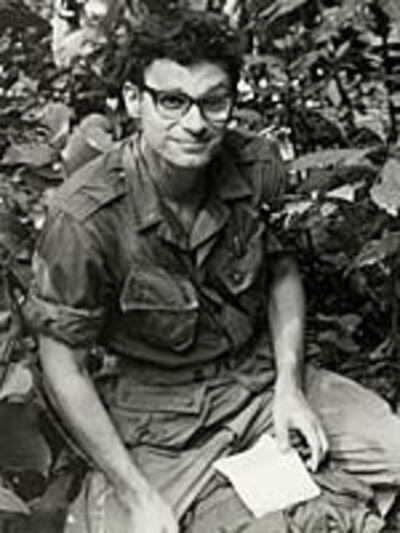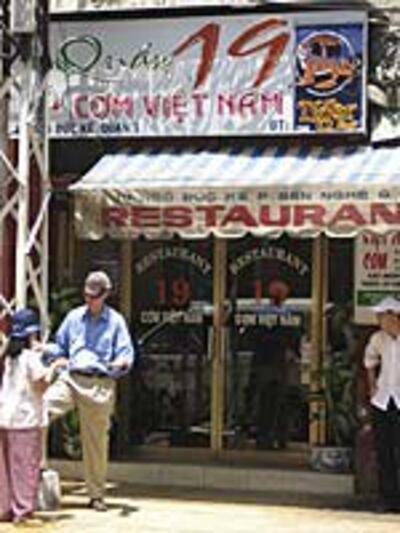
First the heat hits you - nearly 98 degrees Fahrenheit at midday. The airport concrete blasts back at you like a furnace. After more than two decades' absence, I'd forgotten how hot it can get in Saigon.
Then the traffic assails you. Hundreds of Vietnamese on motorbikes moving in seemingly chaotic and opposing streams - sometimes as many as six to eight across. Each rider seems heedless of the others, bent on getting a few yards ahead of the competition.
Finally, the beauty that has always captivated foreigners - three young women on bicycles in the midst of the motorbike maelstrom. They're dressed in the immaculate, traditional white ao dai, tightly-fitted at the top and free-flowing from the waist down.
How will they survive this traffic? I've never been able to figure it out, but somehow the intrepid butterflies float through, unperturbed, gazing straight ahead.

I'm with my son Matt on vacation, here as a tourist. It's a liberating feeling. I don't have to write any reports, do any assessments, or meet any officials. I just want Matt to get an introduction to Vietnam, the country where I spent more years than any other during an 18-year career as a correspondent in Asia.
One of the first things we discover is that with the exception of Communist Party officials and the state-controlled media, virtually no one calls Saigon by its official name, Ho Chi Minh City.
We've chosen to stay at the old Continental Hotel in the center of Saigon, partly because I thought the hotel might retain some its old charm.
It was the hotel where I spent my last few weeks in Saigon in April 1975, departing just as North Vietnamese tanks captured the city. And it was the hotel where the British novelist Graham Greene lived on and off when he was doing research for his novel The Quiet American.
The old hotel has been "upgraded." The Continental Shelf, a once open-air expanse where I drank endless glasses of soda chanh, or soda water with lime juice, has been closed in, hermetically sealed. It's now an Italian restaurant offering a nice breakfast buffet. Service is good. But it's just not the same old slightly seedy but charming hotel any more.
Gone are the war maps on the walls, the sandbags piled shoulder-high in front of the building, and blast tape crisscrossing the windows to prevent glass from splintering in a rocket attack.
An old colleague, Richard Pyle of the Associated Press, says that what he misses most are the bizarre characters who used to show up at the Continental as well as the lizards that wandered freely through the corridors
Pyle is here for a reunion of war correspondents and photographers marking the 30th anniversary of the fall of Saigon.
Matt and I leave the Continental behind and head out to look for my old office near the river. In place of the office at No. 19 Ngo Duc Ke Street, we find a Vietnamese restaurant, Restaurant 19.
Gone are the war maps on the walls, the sandbags piled shoulder-high in front of the building, and blast tape crisscrossing the windows to prevent glass from splintering in a rocket attack.
Employees at the restaurant appear amused when I tell them that I used to pound on a typewriter in the late 1960s at the spot where they are now serving lunch to two Australian tourists.

This was the old office of United Press International (UPI) where one of our editors sometimes got so angry at our editors in New York that he threw his typewriter against the wall and watched it bounce around the floor.
On the top floor of the building lived the legendary UPI correspondent Al Webb, who was said to get early warning of rocket attacks. Webb's Siamese cat Snuffy, the story goes, was able to hear rockets coming in and would then begin furiously spinning around. We had only one source for the hallowed tale of the cat - Webb himself - but we believed it.
After a meal of frog, eel, fish and noodles at Restaurant 19, Matt and I search nearby for my old apartment on Nguyen Hue Boulevard. The apartment served as my office when I worked for The Christian Science Monitor in Saigon 1970-73. We find a vacant lot.
The old apartment building, like so many others, has been demolished. A sign proclaims that a new high-rise complex at the site called "Times Square" will contain a hotel, shopping mall, and entertainment center.
We do find several streets in central Saigon that are still elegantly shaded by trees and marked by facades from the French period. But these are dwarfed by new buildings springing up everywhere.
Produced for the Web by Maggy Sterner
In the 1960s and 1970s, RFA Executive Editor Dan Southerland covered the Vietnam War. He went back recently for 30th anniversary of the fall of Saigon.
